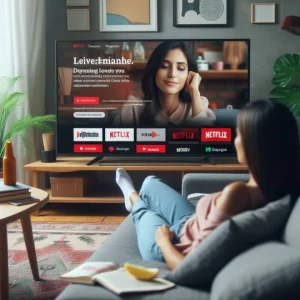Introduction In the ever-evolving world of television and digital media, streaming TV has rapidly gained ground as the go-to platform for content consumption. With this rise, streaming TV advertising has also grown in importance for marketers, brands, and advertisers. As we move into 2024, understanding the landscape of streaming TV advertising is crucial for businesses
Introduction
In the ever-evolving world of television and digital media, streaming TV has rapidly gained ground as the go-to platform for content consumption. With this rise, streaming TV advertising has also grown in importance for marketers, brands, and advertisers. As we move into 2024, understanding the landscape of streaming TV advertising is crucial for businesses aiming to stay relevant and reach their audiences effectively.
The Growth of Streaming TV in 2024

Image by: Yandex.com
Streaming TV has exploded in popularity over the past few years, thanks to the increasing number of platforms available, such as Netflix, Hulu, Disney+, Amazon Prime, and newer services like Peacock and Apple TV+. Consumers have embraced the convenience of on-demand content, which allows them to watch their favorite shows and movies without traditional TV’s limitations of time slots and commercials.
This rise in streaming has not gone unnoticed by advertisers. In 2024, streaming TV is expected to surpass traditional TV in advertising revenue, a monumental shift in the media landscape. The ability to target specific audiences with precision makes streaming TV an attractive option for advertisers, especially in a world where traditional TV viewership is declining.
What makes streaming TV advertising different?

Image by: Yandex.com
Streaming TV advertising offers several advantages over traditional broadcast TV advertising. One of the primary differences is the ability to target specific audiences. Streaming platforms gather extensive data on their viewers’ habits, preferences, and demographics. This allows advertisers to show ads to specific groups rather than relying on a one-size-fits-all approach.
Another key distinction is the ad formats available on streaming platforms. These can range from pre-roll and mid-roll ads to interactive ads, allowing for more engaging and dynamic ad experiences. Advertisers can also leverage the flexibility of ad placement and timing, with the option for viewers to skip certain ads or choose content based on their preferences.
Moreover, the shift to streaming TV is pushing advertisers to embrace new metrics for measuring success. Instead of just focusing on traditional TV ratings and broad reach, streaming TV advertising can track more granular data, including how many viewers actually engaged with an ad, how long they watched it, and whether they took any action afterward, such as visiting a website or making a purchase.
The Benefits of Streaming TV Advertising in 2024

Image by: Yandex.com
- Precision Targeting: Streaming platforms have vast amounts of data on their users. Advertisers can use this data to target specific audience segments based on interests, behaviors, location, and more. This level of precision was not possible with traditional TV.
- Interactive Ads: With streaming, advertisers can engage viewers in new ways. Interactive ads allow viewers to click on links or make choices during the ad, driving engagement and providing more insight into viewer preferences.
- Cost-Effective: As streaming TV continues to grow, advertising costs are expected to be more affordable compared to traditional TV. This provides an excellent opportunity for small and medium-sized businesses to reach a larger audience without the hefty price tag of traditional TV ads.
- Real-Time Analytics: Streaming platforms provide real-time analytics that advertisers can use to gauge the effectiveness of their ads. This data includes metrics like how many viewers watched the ad, their demographic breakdown, and if they took any actions afterward.
- Shorter Ads with Greater Impact: Viewers on streaming platforms often see fewer ads, making them more receptive when ads do appear. Additionally, advertisers can create shorter, more impactful ads that are more likely to hold the viewer’s attention.
Challenges of Streaming TV Advertising in 2024

Image by: Yandex.com
While there are many benefits to streaming TV advertising, there are some challenges that advertisers should be aware of in 2024:
- Ad Fatigue: With the increase in streaming content, viewers may experience ad fatigue if they are bombarded with too many ads during their viewing experience. Balancing ad frequency is key to keeping the audience engaged without overwhelming them.
- Ad Skipping: Some streaming platforms, particularly those with subscription models, allow users to skip ads entirely. This can result in lower engagement rates, particularly for those relying on ad-supported models.
- Fragmentation: The sheer number of streaming platforms and services available can make it difficult for advertisers to reach their target audience effectively. Each platform has its own ad strategy, audience, and format, requiring marketers to adjust their campaigns accordingly.
- Measurement Complexity: While streaming TV advertising offers real-time analytics, measuring the full impact of an ad campaign can still be challenging. Advertisers need to connect ad interactions with actual consumer behavior and sales, which can sometimes be difficult.
The Role of Programmatic Advertising in Streaming TV
Programmatic advertising has gained traction in the world of streaming TV, allowing advertisers to automate the buying and selling of ad space in real time. This system uses algorithms to place ads based on user data and behavior, ensuring that the right ads are shown to the right people at the right time.
In 2024, programmatic TV advertising is expected to grow significantly as more advertisers embrace automation. It simplifies the ad-buying process, reducing the time and cost involved while improving targeting efficiency. For advertisers, programmatic TV advertising ensures that ads are being delivered to the most relevant audiences, maximizing ROI.
Key Players in Streaming TV Advertising

Image by: Yandex.com
Several major players in the streaming TV advertising space include:
- Netflix: Although traditionally ad-free, Netflix has introduced an ad-supported tier in 2024 to diversify its revenue streams and provide advertisers with access to its massive user base.
- Hulu: One of the pioneers in ad-supported streaming, Hulu continues to offer targeted ad options for advertisers, with a robust analytics platform to track ad performance.
- Amazon Prime Video: Known for its strong integration of ads during the shopping experience, Amazon is focusing on monetizing its streaming service through targeted advertising.
- YouTube TV: As part of Google, YouTube TV offers unique advertising opportunities that tap into Google’s vast data infrastructure to provide highly targeted ads.
- Disney+ launched an ad-supported tier, capitalizing on its extensive content library to attract advertisers.
The Impact of Ad-Free Options

Image by: Yandex.com
One of the major challenges for streaming TV advertising is the growing popularity of ad-free subscription tiers. Many viewers are opting for premium versions of platforms like Netflix, Hulu, and Disney+, where they can watch content without interruptions. This means that a significant portion of the audience is not exposed to ads, reducing the reach for advertisers. To counter this, many streaming platforms are now introducing hybrid models, where users can choose to pay less for a service with ads. This shift is providing new opportunities for advertisers to reach users at lower price points while balancing viewer preferences.
How Data is Revolutionizing Advertising
Data plays a crucial role in streaming TV advertising. Platforms collect detailed information about their users, such as what they watch, when they watch it, and even how they interact with ads. This data is used to create highly targeted campaigns that reach the right people at the right time. In 2024, advertisers are able to track viewers’ actions more accurately than ever before, including how many people watch an ad, how long they stay engaged, and whether they make a purchase. This data-driven approach ensures that advertising dollars are being spent more efficiently and that ads are relevant to the audience.
Future Trends in Streaming TV Advertising

Image by: Yandex.com
- Increased Personalization: As data collection becomes more sophisticated, streaming platforms will continue to improve their ad targeting. Expect even more personalized ad experiences, with ads tailored to individual preferences, viewing habits, and behavior.
- Shoppable Ads: As e-commerce continues to grow, streaming TV ads will increasingly incorporate shoppable features, allowing viewers to purchase products directly from the ad.
- Augmented Reality and Interactive Ads: Augmented reality (AR) and virtual reality (VR) technologies are likely to play a larger role in streaming TV advertising. By 2024, expect ads that allow viewers to interact with products in new and immersive ways.
- Hybrid Models: As more streaming services offer both ad-supported and ad-free tiers, hybrid models will become more common, allowing viewers to choose their preferred ad experience.
Comparative Table: Streaming TV Advertising vs. Traditional TV Advertising
| Feature | Streaming TV Advertising | Traditional TV Advertising |
|---|---|---|
| Targeting | Highly targeted based on viewer data | Broad targeting, mass audiences |
| Ad Formats | Pre-roll, mid-roll, interactive ads | Primarily commercial breaks |
| Cost | More affordable for small businesses | High costs for ad placements |
| Measurement | Real-time analytics, precise tracking | Nielsen ratings, broad data |
| Ad Fatigue | Less frequent ads, higher engagement | Potential for viewer fatigue |
| Viewership | On-demand, flexible viewing | Scheduled, fixed programming |
Analysis Table: Streaming TV Advertising Effectiveness
| Metric | Impact of Streaming TV Ads |
|---|---|
| Ad Engagement | Higher due to precise targeting |
| Cost Efficiency | More affordable than traditional TV |
| Audience Reach | Expanding, especially among younger audiences |
| Real-Time Tracking | Immediate feedback on performance |
| Ad Skip Rate | Potentially higher on some platforms |
| Consumer Action | Higher likelihood of conversions and purchases |
Conclusion
In conclusion, streaming TV advertising is transforming the way brands reach their audiences. While there are challenges, such as the rise of ad-free options and difficulties in measuring ad success, the benefits are clear. Streaming offers a powerful way to target and engage viewers in a personalized way, and it will continue to grow in importance in the coming years. As technology evolves, advertisers will find new ways to make ads more relevant, interactive, and impactful for their audiences.






















